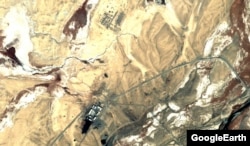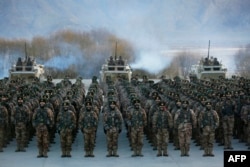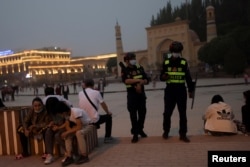Near SHAYMAK, Tajikistan -- In a remote stretch of land near the Wakhan Corridor not far from Tajikistan’s mountainous border with northeastern Afghanistan, China's regional ambitions are adjusting to a new reality on the ground.
Next to an old Soviet outpost and believed to have existed for at least five years, a collection of strategically located buildings and lookout towers controlled by Chinese troops are part of Beijing's nascent but growing hard-power footprint in the region focused on security in neighboring Afghanistan.
Though both the Chinese and Tajik governments officially deny the existence of the base and Chinese personnel, a visit by an RFE/RL source near the compound and the surrounding area saw Beijing’s first military footprint in Central Asia in full swing as it finds itself at a crossroads following the Taliban’s August takeover of Afghanistan.
Through interviews with current and former officials in Afghanistan and Tajikistan, details provided by people living near China’s unofficial military base, expert analysis, and observations by an RFE/RL source in the area, an image emerges of a rising China slowly shifting its role into security matters in the region.
But that image is one that Beijing finds increasingly complicated.
China is navigating increasingly strained ties between the Tajik government and the Taliban and searching for a way to cooperate with Afghanistan's new Taliban regime in order to protect its regional interests, particularly targeting Uyghur extremists in Afghanistan, which Beijing has blamed for attacks in its western Xinjiang Province and still views as a threat.
"The situation in Afghanistan is awkward for China," Haiyun Ma, an associate professor at Frostburg State University who studies Beijing’s relations with countries in Central and South Asia, told RFE/RL. "You have a Taliban regime that has ties to terrorists, including Uyghur [extremist] groups, but Beijing is exploring how much it can work together [with it]."
Details about the Chinese military site, such as its funding and ownership, are unclear, as is the exact nature of China’s mission along the Tajik-Afghan border.
But local residents describe regular sightings of military drones flying overhead and the presence of surveillance equipment. While RFE/RL could not independently corroborate which country operates the drones, their use points to a growing monitoring role at the facilities.
Two locals who had visited the facilities on multiple occasions and spoke to RFE/RL under condition of anonymity said the site consisted of Chinese, Afghan, and Tajik personnel and that an arrangement allowed for information to be gathered and shared among all three parties.
But the Taliban’s return to power in Kabul has disrupted this cooperation, according to a Tajik government source who spoke to RFE/RL on condition of anonymity as he was not authorized to speak to the media.
According to the official, the Afghan contingent has not been replaced since the fall of the Western-backed government in Kabul on August 15. Afghan troops had previously rotated out every two months, he said, but the facilities now only consist of Chinese and Tajik personnel.
This presents another wrinkle for Beijing as it looks to solidify its presence in Tajikistan and adjust to the shifting situation in Afghanistan, particularly how willing and able the Taliban is to cooperate on counterterrorism.
Beijing has forged a pragmatic and, at times, tense working relationship with the Taliban over the decades, and RFE/RL reported earlier this month -- citing Afghan and Tajik military sources -- that the Taliban relocated Uyghur fighters from an area near Afghanistan's 76-kilometer border with China.
China has moved to expand its military links to the region as well, conducting bilateral military exercises with Central Asian countries bordering Afghanistan and forming in 2001 the Shanghai Cooperation Organization (SCO) -- a Beijing-led security bloc that also includes Kazakhstan, Kyrgyzstan, India, Pakistan, Russia, Tajikistan, and Uzbekistan.
China also funded and trained an Afghan brigade that operated in the Wakhan Corridor, according to a 2018 report by Hong Kong's South China Morning Post, a report that Beijing denied, saying it had not built a training camp and there will be "no Chinese military personnel on Afghan soil."
"China sees counterterrorism as an effective way to address its concerns and expand its influence in Central Asia," said Ma.
China's stepped-up security presence is driven in part by a desire to protect its investments and by Beijing's view that Central Asia can act as a bulwark against extremism in Xinjiang -- where the Chinese government has imprisoned more than 1 million Uyghurs, Kazakhs, Kyrgyz, and other Muslim minorities in internment camps.
The Chinese government has faced severe international criticism for human rights abuses in Xinjiang and some Western parliaments have accused the camp system as amounting to genocide, but Beijing has justified its crackdown as necessary in order to curb Islamist extremism in the area.
The militants are believed to be members of the Turkestan Islamic Party (TIP) -- a Uyghur extremist group that Beijing blames for unrest in Xinjiang and refers to by its former name, the East Turkestan Islamic Movement (ETIM).
The Taliban allowed Uyghur fighters to operate in Afghanistan during its rule in the 1990s and is believed to still have links to them. China has demanded on multiple occasions that the Taliban cut any ties with the militants.
But while the reported relocation marked a sign of coordination between the Taliban and Beijing, it is unclear if the group will hand over the fighters to Chinese authorities, an official in Tajikistan's state border services, who spoke on condition of anonymity, told RFE/RL.
"The question is whether China can expect the Taliban to be a reliable partner," said Ma. "The Taliban’s ideology means there will be limits on what it is willing to do to work with Beijing."
Outpost On China’s Western Frontier
While the Chinese deployment in Tajikistan represents a strategic and symbolic step by Beijing toward playing a bigger part in the region's security matters, it is a modest presence in a remote area located more than 132 kilometers from Murghab, the nearest town, which has a population of about 4,000.
But the unofficial base is part of a wider expansion of Chinese economic and political influence across Central and South Asia in recent years under the guise of President Xi Jinping’s signature, multibillion-dollar Belt and Road Initiative, of which the Tajik government has become an enthusiastic partner.
China has moved to expand its military links to the region as well, conducting bilateral military exercises with Central Asian countries bordering Afghanistan and forming in 2001 the Shanghai Cooperation Organization (SCO) -- a Beijing-led security bloc that also includes Kazakhstan, Kyrgyzstan, India, Pakistan, Russia, Tajikistan, and Uzbekistan.
China also funded and trained an Afghan brigade that operated in the Wakhan Corridor, according to a 2018 report by Hong Kong's South China Morning Post, a report that Beijing denied, saying it had not built a training camp and there will be "no Chinese military personnel on Afghan soil."
"China sees counterterrorism as an effective way to address its concerns and expand its influence in Central Asia," said Ma.
China's stepped-up security presence is driven in part by a desire to protect its investments and by Beijing's view that Central Asia can act as a bulwark against extremism in Xinjiang -- where the Chinese government has imprisoned more than 1 million Uyghurs, Kazakhs, Kyrgyz, and other Muslim minorities in internment camps.
The Chinese government has faced severe international criticism for human rights abuses in Xinjiang and some Western parliaments have accused the camp system as amounting to genocide, but Beijing has justified its crackdown as necessary in order to curb Islamist extremism in the area.
This focus on Xinjiang is reflected in the deployment in Tajikistan.
A 2019 Washington Post report found that Chinese personnel at the base were distinct from the People's Liberation Army, China’s main military force, and were instead paramilitary units, likely from the People's Armed Police.
That paramilitary unit has conducted drills in recent years with Central Asian militaries and hosted officers at its training academies. The People's Armed Police has also played a prominent role in the repression of Uyghurs and other Muslim minorities in Xinjiang.
Concerns over the porous borders of Afghanistan and Tajikistan also led to a secret agreement between both countries and Beijing that The Wall Street Journal reported in 2019 granted China the right to repair or expand 30 to 40 preexisting outposts on the Tajik side of the border.
The alleged agreements have led to Chinese personnel replacing their Tajik counterparts along lengthy sections of the Tajik-Afghan border where they patrol on their own, according to the report. A Tajik official confirmed this account to RFE/RL.
"The overall numbers of Uyghur fighters [are] small, and China has exaggerated them, [but] Afghanistan now has the potential to become a magnet and safe haven for jihadi groups of all stripes," Daniel Markey, a former State Department official and expert on South Asia at the U.S. Institute of Peace, told RFE/RL. "China has legitimate reasons to want to better seal up its land border."
China's 'War On Terror'
Chinese military strategists and policymakers have long been anxious about the potential threats of extremism in the Middle East and Central Asia spreading to China.
In a 2014 speech by President Xi to the country's communist leadership -- obtained as part of a leak of documents by The New York Times in 2019 -- the Chinese leader warned that conflict in Afghanistan and Syria could directly affect Xinjiang and amplify risks for China.
Uyghur militants had traveled to and fought in both countries, Xi said, and could return to western China as experienced fighters to push for their cause of an independent homeland that they call East Turkestan.
"After the United States pulls troops out of Afghanistan, terrorist organizations positioned on the frontiers of Afghanistan and Pakistan may quickly infiltrate Central Asia," the Chinese leader said. "East Turkestan’s terrorists -- who have received real war training in Syria and Afghanistan -- could at any time launch terrorist attacks in Xinjiang," he claimed.
It was these concerns that led to Beijing taking up its current foothold in Tajikistan, Edward Lemon, an expert on Central Asia at Texas A&M University, told RFE/RL.
"The building of the facility in Tajikistan was directly linked to the perception by the Chinese government that the border between Tajikistan and China was a weak spot through which Uyghur militants based in Afghanistan could pass," he said.
For decades, Beijing has moved to suppress all forms of Uyghur resistance to its rule. Muslim ethnic minorities make up the majority of Xinjiang’s population of 25 million, with Uyghurs -- who speak a Turkic language and have long faced discrimination and restrictions on their cultural and religious activities -- the largest among them.
The push for an independent homeland has long been a nonviolent political cause for many Uyghurs in China and abroad, but that desire coupled with repression against the ethnic group has also fueled a more extreme movement willing to carry out anti-Chinese violence over the years.
In the 1990s, ETIM, a Uyghur militant group fighting to separate from China, emerged in Afghanistan and received protection from the Taliban.
Beijing later courted and negotiated with the Taliban leadership to cut ties with the group and, similar to now, former Taliban leader Mullah Omar relocated the fighters and restrained the militants' activities. But they stopped short of expelling ETIM or handing them over to Chinese authorities.
Beijing accused ETIM of helping to orchestrate attacks inside China, but little was heard from the group throughout the 2000s, especially after its leader was killed in 2003. That was until the group calling itself TIP issued a video in 2008 in which it threatened to attack China during that year's Summer Olympics, held in Beijing. TIP said it was a successor to ETIM, although China continues to call it by the older name.
TIP has grown because of Syria, where thousands of Uyghurs who left China are believed to have gone since 2014, adding to fears that they could relocate to Afghanistan or other areas neighboring China’s western border.
While Western officials and analysts question the ability of Uyghur militants to carry out significant attacks inside China, a surge in anti-government incidents in Xinjiang -- including 2009 ethnic riots and a May 2014 attack on an outdoor market that killed 39 people -- helped fuel Beijing’s current crackdown on Uyghurs.
At home, this took the form of a "people’s war" on terrorism, which escalated into the current camp system in Xinjiang. Abroad, this led to an extended campaign to target, surveil, intimidate, and extradite Uyghurs of all backgrounds around the world.
Research published in June by the Uyghur Human Rights Project and the Oxus Society for Central Asian Affairs suggests at least 395 Uyghurs have been deported, extradited, or rendered back to China since 1997, though the true figure could be higher.
Complicated Partners
Militant threats remain the focus of China's unofficial presence in Tajikistan, but the facilities and Beijing's counterterrorism agenda are also linked to the country's complicated geopolitical relationship with Russia, as well as the current tense relationship between the Taliban and the Tajik government.
Since the collapse of the Soviet Union, Russia has maintained its edge as Central Asia’s main security guarantor and sees the region as part of its traditional sphere of influence, even while the Kremlin has come to accept China's economic supremacy.
Moscow maintains a 7,000-troop military base outside of Dushanbe, the Tajik capital, and has begun to reinforce its security footprint in the country with tanks and heavy weaponry following the Taliban's return to power.
Wary of provoking Moscow, Beijing moved cautiously as it expanded its presence in Tajikistan.
In 2017, the Development Research Center, an influential Beijing-based think tank linked to China’s cabinet, hosted a handful of prominent Russian researchers to probe their reactions to a Chinese security deployment in Tajikistan.
Alexander Gabuev, a senior fellow at the Carnegie Moscow Center, was one of the participants. He told RFE/RL that the private meeting was focused on explaining China's motivations for such a presence and that its purpose was for logistics and monitoring rather than a formal military base.
"It was mostly about sensing where the Kremlin's red lines would be on certain issues and what Moscow could or couldn't tolerate from China in Tajikistan," Gabuev said, noting that the participants were asked whether the use of private mercenaries or official Chinese personnel would be more tolerable for Russia.
Both China and Russia have concerns about instability spreading from Afghanistan and of the country becoming a staging ground for terrorist groups, but the arrival of Chinese servicemen in Central Asia was initially an unwelcome development for the Kremlin, Gabuev said.
"[The base] was an unpleasant surprise for Russia, but Moscow understands quite well that the Chinese military presence will be limited to Tajikistan," he said. "[The Kremlin] doesn’t want a broader Chinese expansion across the region, but since China is already there they will look to cooperate."
China and Russia have thus far looked to solidify their defenses around Afghanistan and have cautiously engaged with the Taliban, but swelling tension between Kabul and Dushanbe could also further complicate Beijing's ambitions in the region.
Emomali Rahmon, Tajikistan’s autocratic president, has accused the Taliban of carrying out "terrible violence" against the Afghan people and said he will not recognize a Taliban government that fails to reflect the ethnic diversity of Afghanistan. Dushanbe has also hosted several exiled politicians and former officials from the Afghan government that was ousted by the Taliban in August.
These acts have led to a spiraling row between the two sides and raised the possibility of cross-border violence. An official in Dushanbe raised the alarm when he said ethnic Tajiks from Afghanistan who had fought with the Taliban were planning to cross over into Tajikistan and were amassing weaponry, RFE/RL reported.
This led to Salam Hanafi, the Taliban's acting deputy prime minister, to warn Tajikistan not to interfere in Afghanistan's domestic affairs, saying that "every action has a reaction."
The escalation has already prompted the Kremlin to react, with Moscow saying Russia is ready to protect Tajikistan in the event of any incursions from neighboring Afghanistan.
The outbreak of fighting between the two sides remains low at the moment, says Lemon, but the added tensions are an unwelcome development for Beijing.
"This could put [China] in a difficult situation if fighting came near where Chinese troops are stationed," he said.
Preparing For A New Era
A suicide bombing on October 8 at the Gozar-e Sayed Abad Mosque in the northern Afghan city of Kunduz killed at least 50 people and injured more than 140 others in the deadliest attack since U.S.-led international forces withdrew from the country.
The attack was claimed by Islamic State-Khorasan (IS-K), the Afghan affiliate of the terrorist group that remains violently opposed to Taliban rule.
The Amaq News Agency, the group's official propaganda organ, also claimed that the attacker was a Uyghur militant who joined the group and carried out the bombing because the Taliban was working with China to "expel and oust [Uyghurs]" from Afghanistan.
While the bomber's identity has not been independently confirmed, the development gets to the heart of what many analysts say is a central challenge for China as it focuses on counterterrorism in the new Afghanistan.
The base in Tajikistan and the thrust of Beijing’s efforts have concentrated on securing Chinese borders and preventing militants from staging attacks inside the country. But with targeting China itself becoming more difficult, many militants have shifted their focus to Chinese targets spread out across Central and South Asia.
Kyrgyzstan's state security service said that a 2016 suicide bombing of the Chinese Embassy in Bishkek was carried out by an Uyghur militant from TIP and was financed by Al-Qaeda’s Nusra Front. Islamic State, meanwhile, took credit for kidnapping and killing two Chinese teachers in Pakistan in 2017.
Pakistan, which is home to nearly $60 billion worth of Chinese investment into infrastructure through the China-Pakistan Economic Corridor (CPEC), also saw a series of violent assaults from different groups against Chinese workers in July and August, including two bombings and a gun attack.
The Kunduz bombing and the spate of attacks across the region highlight the growing array of militant groups targeting Chinese interests and the difficult path ahead for Beijing as it pushes the Taliban to cooperate with its counterterrorism efforts, which are narrowly focused on Uyghur fighters.
According to Ma, if at the urging of China the Taliban targets Uyghur militants too hard, they could begin to "feel threatened and look to partner potentially with other groups, like [IS-K]."
"If you press the Taliban too hard to cooperate, you can undermine their legitimacy and they will have less control over these [fighters],” said Ma. "This is a central dilemma for China."



















